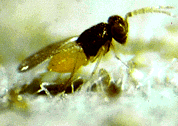Common Name: Encarsia, Whitefly parasite
Scientific name:
Encarsia spp.
Hymenoptera:Aphelinidae
Type
Larva parasitoids
Hosts
Various whitefly species
Description
Eggs are found inside the body of the host larva.
The larvae develop within the whitefly larvae passing through four larval stages.
The host pupa turns black when Encarsia pupates inside the whitefly. Adult wasps emerge from the parasitized pupae by chewing a hole in the top of the scale.
Adults are
very tiny wasps, about 1 mm in size. These parasitic wasps can look actively and effectively for whiteflies. They can cover distances of 10-30 m looking for hosts. Adult females attack young whitefly larvae by stinging and laying eggs inside them.
An adult female wasp can lay 60-100 eggs. The life cycle is completed within 2-4 weeks depending on the climatic conditions. Adults can live for 30 days but are active for about 10 days.
Adult wasps feed on honeydew and the body fluids of whitefly larvae. They also feed directly on the scales. However, honeydew restricts their movements so that it is difficult for them to have a wider feeding coverage.
With the exception of the adult, all stages of Encarsia occur inside the whitefly host.
Conservation
Conserving natural enemies is probably the most important practice farmers could do.
Practicing multiple cropping (including flowering crops) provides pollen, honeydew, and nectar for adult wasps. The
practice can increase the diversity of habitats that provide shelter and other food sources to the natural enemies.
Some Encarsia species are native to crop production environments. When introduced, they have the tendency to adapt to the local environments.
Weekly field monitoring or a visual inspection of plants is important to notice the presence of pests and beneficial insects in order to consider when to make pest management decisions. If possible, avoid the indiscriminate use of pesticides.
External links
References
- CABI. (2001): Crop protection compendium. Global module, 3rd edition. CAB International Publishing. Wallingford, UK.

